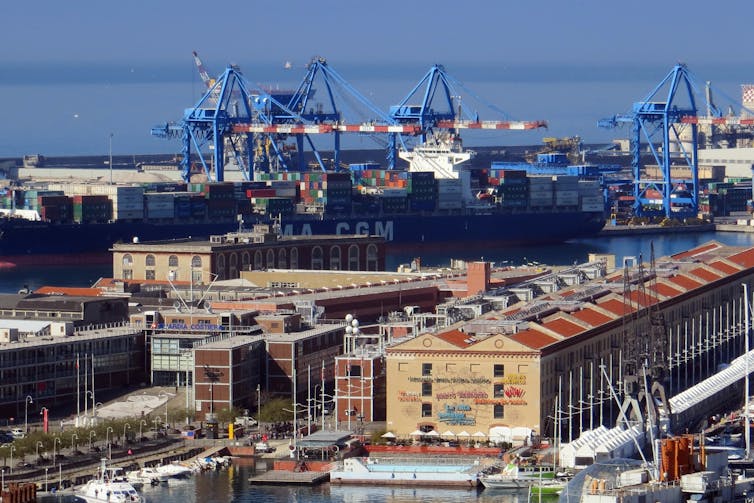China and Italy’s presidents shake hands. EPA-EFE/Alessandro Tarantino / Pool
Winnie King, University of Bristol
Italy is projected to be the first G7 nation to officially endorse China’s Belt and Road Initiative (BRI). And that’s raising the ire of both the European Union and the United States.
Having re-entered a recession at the end of 2018, the eurozone’s third largest economy is welcoming China’s President Xi Jinping for a three-day state visit. While there, Italy is expected to sign a memorandum of understanding – making it the 124th nation to sign up for this geographically expansive infrastructure and investment strategy.
Proposed in 2013, China’s BRI is a transcontinental project that focuses on infrastructure investment and projects that promote regional cooperation, development and connectivity. It offers participants a means to secure their trade, energy and transport network. China presents it as a win-win relationship aimed at mutual growth. But there are suspicions regarding China’s motivations – it’s seen as a way for China to embed its global influence – and it could make participants dependent on China. Today the BRI is linked to two-thirds of the world’s population, and has to-date seen investment of more than US$1 trillion.
The Italian job
While the current Italian government has not been fully unified toward China, a severe economic downturn has made the world’s second largest economy look more appealing to it. Alberto Bradanini, Italy’s former ambassador to China, has stressed that Europe’s own indecision and inability to tackle trade deficits with China (of which Italy contributed approximately €176m, or an eighth of the EU’s total trade deficit) is a key motivator behind this decision.
Italy wants to enhance its “Made in Italy” brand through increasing trade – especially in the form of exports – to China. The BRI is seen as a vehicle to achieve this. Italy offers goods (in particular luxury goods and foodstuffs) that are attractive to China’s growing middle class and increasingly affluent population.
China is also interested in investing in Italian firms. More significant, however, are Italy’s key infrastructure assets. This would enhance the transport and trading network of the BRI, giving it strategic access to Europe. Less than 2% of Italy’s sea imports come from China so there are substantial prospects for growth in that area.
A deal between Genoa’s port authority and shipping firm China Communications Construction Company (CCCC) has already been approved by the Italian government. And the port city of Trieste hopes for something similar. This would offer China and the BRI a more direct route to move goods onto the European continent and an ideal hub for accessing new rail lines and transport networks to Germany, Austria, Slovenia and other regional economies. By giving China access to its ports, Italy is hoping for infrastructure investment from China’s Asian Infrastructure Investment Bank (AIIB) – something the Italian government is trying to link to its role in the BRI.

Alan Kotok / flickr, CC BY
With the port city of Palermo due to be part of Xi’s itinerary, it is clear that China is focused on European shipping terminal options. Following Algeria’s joining of the BRI in mid-2018, Palermo could help establish a new North African trade corridor.
Disunity and discontent
The international response to Italy’s decision has been, at best, mixed. Germany and France have led the charge, raising concerns of China’s poor reputation regarding transparency, unfair BRI practices of favouring Chinese firms, as well as Chinese protectionism restricting European firms from Chinese projects.
The EU is clearly particularly concerned about what Italy’s decision means for the bloc’s China Policy. It is important to note, however, that when it comes to the BRI, Europe’s unified China’s Policy fell as early as 2017. It was then that Premier Li Keqiang’s visited Hungary and the coalition of Central and Eastern European Countries (CEEC), also including Poland and the Czech Republic, signed up to the BRI. Greece, Portugal and Croatia then followed suit.
The US has also derided Italy’s decision to break the G7 position on the BRI. The Trump government has labelled the BRI as a vehicle for debt trap diplomacy and accused the BRI of being nothing but a vanity project.
The growing tensions between China and the US do not help matters. The two sides are locked in a trade war and US charges of espionage against Chinese tech firm Huawei encapsulate its fears over Chinese investment in strategic industries and acquisitions. But traditional alliances seem to have fallen to the wayside, as Telecom Italia has agreed to remain partnered with Huawei.
The full impact of Xi’s visit to Italy will become more clear come April 9 when Brussels is scheduled to host an EU-China summit. In the build up however, the EU’s increasingly China-sceptic leadership has published an official strategy document labelling China a “systemic rival”. Targeting the BRI specifically, it calls upon member states to work together to pressure the Chinese for more accountability and greater transparency in the area of infrastructure and investment projects. Furthermore, on March 18th the EU tabled a proposal calling upon all member states to ban Chinese firms from bidding on public procurement projects.
Italy’s status as a G7 country is a coup for the Chinese leadership and the legitimacy of the BRI. While the prospect of Italy’s participation underscores growing fault lines in the EU’s joint approach to China, China has also been effective at dividing and conquering EU member states by targeting them individually.
So Italy’s decision to join the BRI is significant. But four years ago we saw Italy, France and Germany join China’s AIIB, contrary to US wishes. Therefore, Italy is neither the first, nor will it be the last European economy that will “go rogue” and follow its own national interest with regard to China.![]()
Winnie King, Teaching Fellow East Asian and International Political Economy, University of Bristol
This article is republished from The Conversation under a Creative Commons license. Read the original article.

